|
An early picture which may be dated 1800 shows an officer of the
"Leicestershire Light Horse" wearing a hat instead of a helmet.
 |
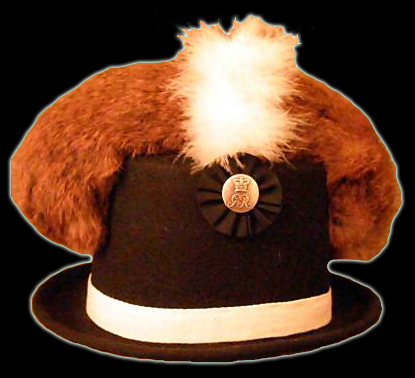 |
| Sketch, by Harry Payne, of the LYC adorned top hat. |
Modern replica of the adorned top hat. |
This practice was common among volunteer infantry and to a
certain degree among cavalrymen. The civilian type round hat
with a wide brim was ornamented in a military fashion. This
particular hat has a large fur crest over the to a bushy feather
plume - white over red - a large black rosette on the left side
on which is placed a metal badge. This was a crowned garter with
what may be the "GR" cypher in the centre.
The raised Yeomanry wore the fur-crested Light Dragoon helmet
(the Tarleton Helmet) as may been seen from a print of 1813 and
an actual helmet. The Helmet has silver white metal fixings with
the regimental title on the label above the peak. No badge was
worn on the side. The presence of chin-scales indicates a later
version of the helmet. The turban was of red silk.
The officers helmet would have had a high crown with a bearskin
fur crest, large white over red hackle and the O/R would have
had a low crown with a "Goat skin" crest. It is not confirmed if
the O/R had a white over red plume, if they did then it would
certainly be a smaller version to that of the Officers.

An LYC Officers early Tarleton Helmet c1800 seen and sketched by Harry
Payne (the artist) at a Military Exhibition in Chelsea, London
in 1890. The Turban is not pink but scarlet.... when Harry Payne
sketched the Helmet it was already 90 years old and the silk
would have faded considerably.
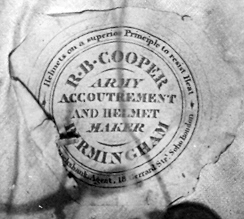
Manufacturer's mark.

LYC Officers Light Dragoon (Tarleton) helmet circa 1820. The
rose ear boss and chin scales are dated circa 1812-17.

Taken from a painting (c1841) of J Kirk, QM of the LYC, here you
can see the colour of the turban and the silver fittings of the
helmet.
In September 1844 the new Bell Top Shako was worn in the new
uniform
(Leicester Chronicle
1844 : The Leicestershire Yeomanry Cavalry).
In a portrait of Lt. Col G A Legh-Keck, an engraving of
1851, shows a broad topped Shako. It is possible that the
original may have been painted many years before . This shako
had a large drooping plume of white feathers, Silver lace around
the top and a front plate of gilt and silver. An existing shako
has large rings on the chin chain and lion head ear bosses. The
front plate had "LYC" on a plate with sharply cut ends and a
triple scroll with "Prince Albert's Own".

The picture (above) is taken from a portrait of Lt. Col G A
Legh-Keck from 1856.

An example of the Shako worn circa 1850; note the black horse
hair stand plume. The Shako plate has a separate crown above, and the scroll work "Prince
Albert's Own".

Bell top Shako interior with the makers label.

LYC Officers forage cap c1861
A black leather helmet introduced about the time of the Crimean
war had the same plate in front as well as the same ear bosses.
The leather helmet had been tried experimentally by two regular
regiments c1853 but was not taken into general use. One
existing example has a black hair plume issuing from a top ball
and holder similar to that on an Albert helmet all fittings in
white metal.
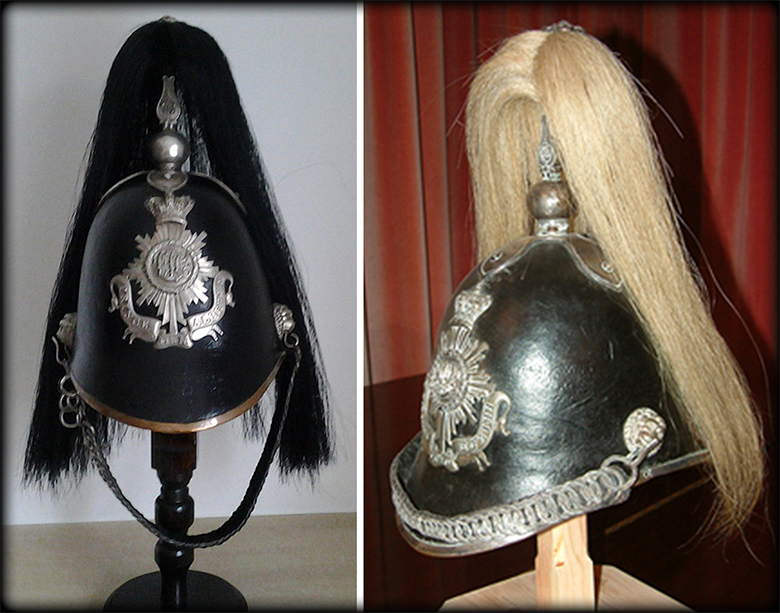
P.A.O Leicestershire Yeomanry Cavalry Helmet circa1860's.
The Black plume was in use from 1859 to 1868 and the White from
1868 to 1870.
This pattern helmet was worn by a number of Yeomanry regiments,
all of which seemed to have adopted it about 1859-60. It was
copied from that experimentally issued to two of the regular
Light Dragoon regiments in 1853-54, but which was not finally
approved for the regular cavalry.
HAWKES No. 78 Book, 1859 : Leicester Yeomanry : Leather helmet.
Like M.A., skull and peaks in one place; all plated mounts, back
bar like M.A.; chain and heads; f front ornt. in G.s.p. star
with crown and scroll. Plume: Black 6 1/2; Mount Inf G.s.p.
Rose, no bottom.
By 1873 the Busby was introduced, with a red bag, somewhat in
RHA style, but with a white over red plume.

 
LY Busby introduced c. 1873 O/R example (left) and
Officers (Right)
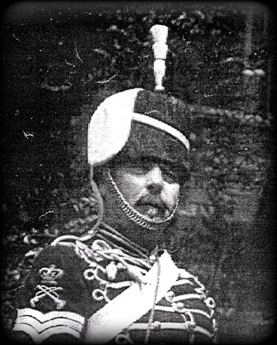
Trumpet Major William Rouse c1897.
The PAOLYC Mounted band wore a Busby with a plain "white" busby
bag and a full white plume.
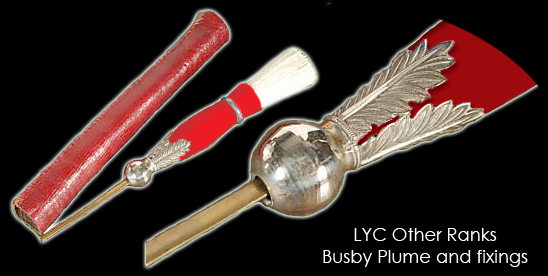


LY Busby cords, Other Ranks (White Cord) and Officers (Silver
Cord).
The busby was worn at certain times, but generally the Hussar
forage cap was worn. The forage cap was worn with a tilt to the
right side and was decorated with varying amounts of silver lace
according to rank. A trooper would have a plain blue cap with a
scarlet band, a
corporal two thin bands of lace slightly separated, a sergeant
one thick band with a sliver top knot and an Officer with a
thick band and decorated lace top .... the level of detail in
the lace would determine the seniority. Generally the ranks had
buttons at the top of the cap silver net covered or blue
according to rank, the officers tended not to have one but there
are examples where they do.
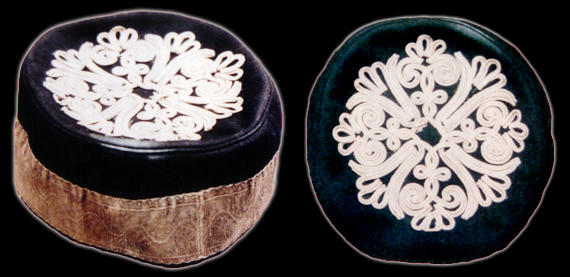
LYC Officers Pillbox Forage Cap, the lace detail is the same as
the 11th Hussars.
| Colour |
Top Figure |
Lace |
Seam |
Button |
| Army Blue |
11th Hussar |
Silver Oak leaf |
Army Blue |
None |
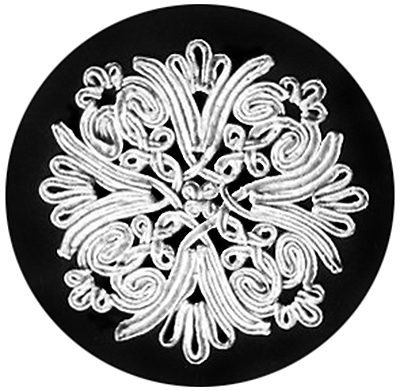
Lily & Pomergranate

The Leicestershire Yeomanry Officers Pillbox forage cap was blue
in the style of the 11th Hussars, with Silver Oak leaf lace,
with no edged seam and no top button.
HAWKES No. 78 Book, 1859 : Leicester Yeomanry : Forage Cap :
Blue top, one-piece; tulip pattern braid top and purl button; no
braid on edge, no peak; 1 3/4" silver oak band.

LYC in 1899 with Hussar forage caps.

The "Pill Box" hat according to NCO Rank. Rank insignia is taken
from a photo of C Squadron 1899.
The PAOLYC Mounted band are recorded as wearing a full scarlet
pill box hat with a silver lace band and top button in an oil
painting of a band member.
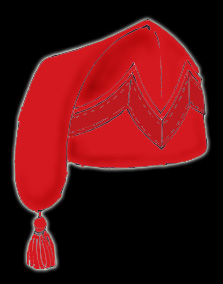
PAOLYC "Bonnet de Police"
(the example above is a representation)
For fatigue and stables men were issued with woollen cloth red hats
with a tassel, these were in the style of the French soft
woollen cap called the "Bonnet de Police"; popular with cavalry
regiments, French and British, in the early 1800's. There
appears to have been two versions, one for smart occasions (as
seen below) and a later knitted wool version for general stable and fatigue
work. The "Bonnet de Police" has been worn, only, by the "other
ranks" of the Yeomanry since the 1880s (possibly since
1873) and peculiar to
the Prince Albert's Own Yeomanry it
seems. The adoption of this hat by
the PAOLYC is possibly due to the "vogue" for all things French
during this period and also its use is in keeping with Hussar
and Light Dragoon Regiments. It could possibly have been in use
by the Yeomanry during the early 1800s, but there is no recorded
evidence for this.

You can clearly see the "Prince Albert's Own" in their smarter
version "Bonnet de Police" worn as an "alternative" to the
pillbox (the Derbyshire Yeomanry can also be seen), this photo
is taken at a boxing match at Croxton Park Camp on the 13th May
1899. The officers organised a boxing
tournament on the evening, with professional pugilists from
London fighting for gold purses.
The pictures below show how the original woollen
hat has evolved to the present day.

Traditionally the turn up would be the colour of the regiments
facing edged in the braid colour and the main body the uniform
colour. The colour & braid of the busby bag would also be
the same. The plain Scarlet Bonnet de Police, of the
PAOLYC, makes sense as the Busby bag for the regiment is simple
and uncomplicated. Officers of the Queens Royal Hussars still
wear an evolution of the "Bonnet de Police" to this day. In the picture below (right) the QRH Brigadier
wears the Green and Gold colours of the 8th (Kings Royal Irish)
Hussars.
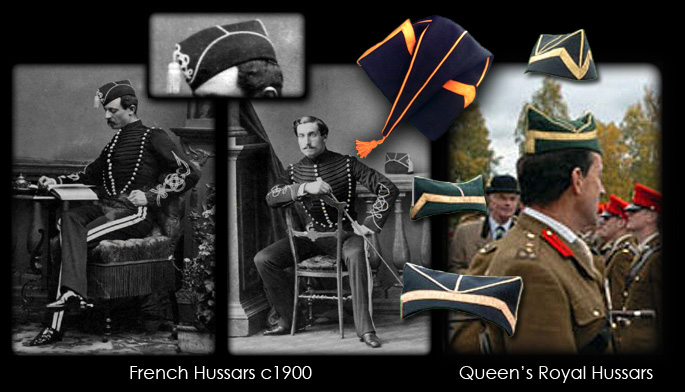


Pictured above is a mid 1900s Cheshire Yeomanry Tent cap.
The "Torin" cap is an evolution of the "Bonnet de Police" and is
worn by British officers from c1885 onwards until the further
evolution, the "Field service Cap" c1900.
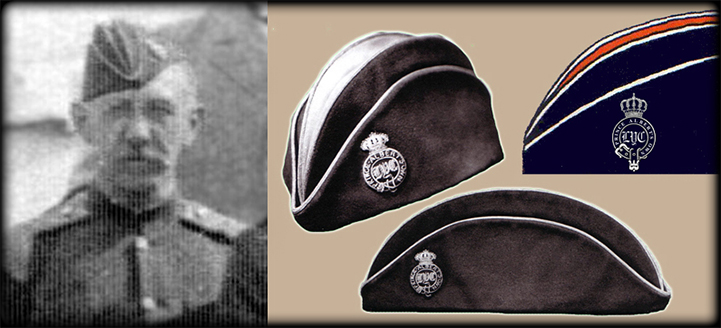
LYC "Torin" (c1890's) or Field Service Cap of the Yeomanry.

A modern copy of the LYC Torin cap.
By the 1890's the "Torin" field cap and the Folding side cap had
been introduced, these were worn with the serge patrol jackets
and were also used with Mess kit. This replaced the Pillbox for
the Officers around this period.
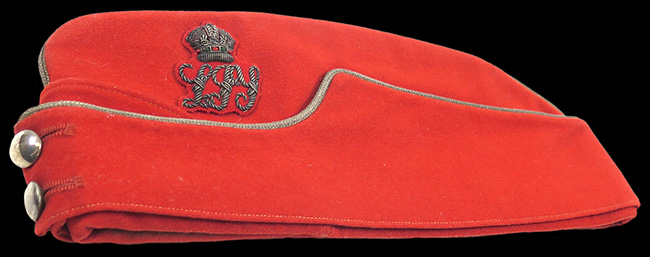
Folding Service dress Side hat with the LIY, still in use today
with the L&D (PAOY). Introduced in 1898.
Extract: Messrs Hawkes : No. 1 or "D" Book of 1869-73
With later annotations dated 4th April 1899 :-
"Service Cap (F.S), new regulation scarlet, per the Adjutant
{Cpt. C T McM Kavanagh, XRH},
silver LYC & crown badge (bullion), 2 G.S.P. vest 1/2 ball
buttons."
1900 : Noted :- "Made for (Captains) Robinson & Willoughby, May
1900, Caps.
1900-01: Noted, Messrs Hamburger "All scarlet, blocked, silver
welts throughout. With LIY and crown (bullion) badge"
South Africa 1900-02
The slouch hat was worn in the 2nd Boer War by the Imperial
Yeomanry and also the Cavalry Pith Helmet, the elongated blunt
back shape proved efficient in protecting against being struck
on the back of the head. Made from "Cork Pith", covered in
cotton twill and a cotton turban, this hat was often "dunked" in
water, before wearing, to create an evaporation effect for
cooling the wearer.

Imperial Yeomanry
Lt. The Hon.
P C Evans-Freke pictured here in the uniform of the Imperial
Yeomanry, his folding Forage cap is the "Imperial Yeomanry" with
a small white metal badge of the Imperial Yeomanry (Prince of
Wales Feathers) with gilt coronet. It had a purple body and peak
with a red crown and gold piping and the buttons were gilt with
white metal POW feathers and gilt coronet. According to W Y Carman's
book on Yeomanry Headdress, the purple seems to have indicated
the "Imperial purple" of Rome and was kept by the new Yeomanry Regiments
such as the "The City" of London Westminster Dragoons and the
Rough Rider's (or the "Devil's Own").
 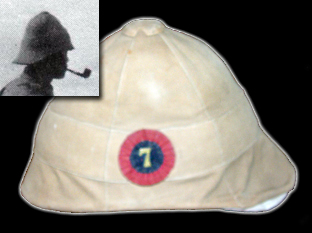
The Slouch hat and Pith helmet worn in the Boer War by the PAOLYC.

A genuine PAOLYC 7thCoy/4thBtn IY pith helmet from the 2nd Boer
War, also showing the interior and makers label (With thanks to
B (LDYPAO) Squadron RY Officers Mess).


Lt F W Martins IY Slouch hat, 7th Sqn/4th Btn IY
(With thanks to B (LDYPAO) Squadron RY Officers Mess).
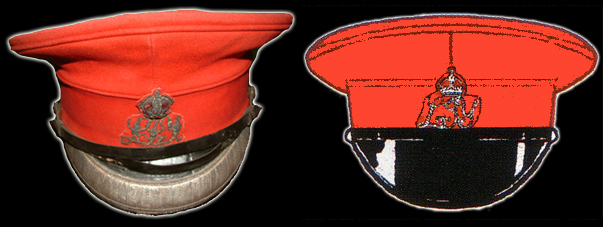
Staff Pattern Peaked Forage Cap, Officers LIY (Field Officer,
Left). Introduced in 1902.
Leicestershire Yeomanry Captain's uniform and cap. A scarce
scarlet dress cap tailored by E. Taut & Sons 485 Oxford Street W.
Scarlet body and crown, with black patent leather peak and
chinstrap. Complete with silvered regimental device and plain
ball pattern buttons. The interior with tailor's details and
stitched silk sweatband.
Leicestershire Yeomanry Officer's scarlet dress cap. A scarce
example tailored by Herbert Johnson London. Scarlet body and
crown, with black patent leather peak and chinstrap. Complete
with silvered Regimental device and plain ball pattern buttons.
The interior with tailor's details, leather sweatband with
pierced initials P.W.P. Complete with a japanned storage tin
bearing a brass name plate Edmund Paget Leicestershire I.Y.

The scarlet "Bonnet de Police" can clearly be seen here in the A
Squadron lines in 1905.

Other Ranks LIY plain blue peaked forage cap and the welt of the
crown was scarlet piping, pre 1908. The cap shown is a more
modern example from the Royal Engineers.

This O/R cap turned up for sale on eBay in December 2009,
unfortunately the date of the cap itself cant be confirmed. The
cap is in very good condition and could be a more modern cap
that has had the LIY badge attached to it (the cap badge was
in-fact an "original" collar badge). However, the centre
band is unusual and the cap buttons are also covered in a
black material therefore could have been used for a funeral. Until another
example appears then it can only be speculated that the cap is
an original.
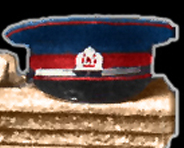
In 1911 the other ranks peaked forage cap changes by the
addition of the red central band and the badge
becomes LY.

The knitted wool version of the PAO "Bonnet de Police" hat is seen here at Diss in
October 1914.
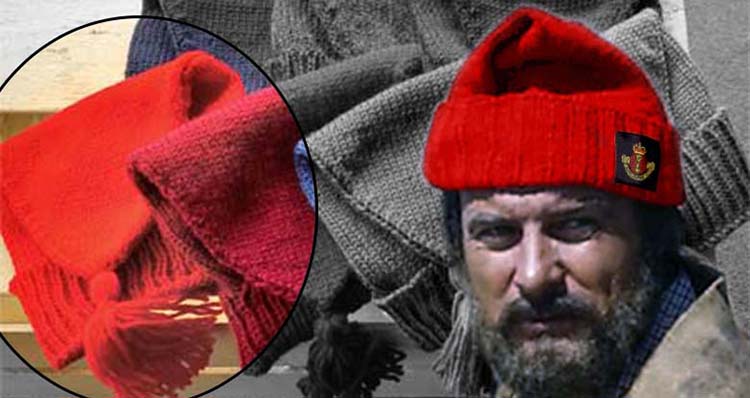
(the example above is a modern replica of the early 1900s kitted
wool version)
World War 1
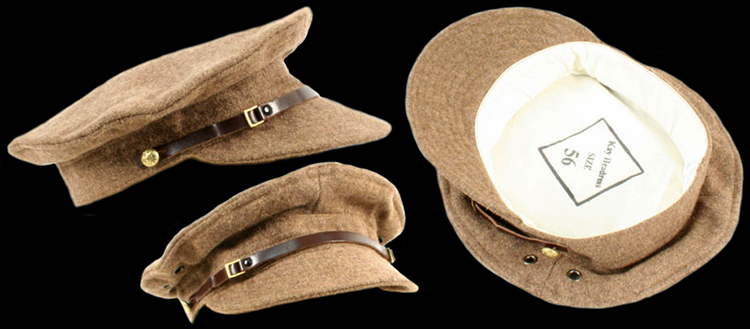
A modern reproduction of the Trench cap.

A modern reproduction of the Trench Cap waterproof.

WW1 BRITISH
OFFICERS RAW EDGE BRODIE WITH ORIGINAL COVER
Brodie helmet complete with it’s original 2-piece khaki cover.
High quality interior with felt lined crown, thick leather liner
with draw string and 2 outer bands of black felt and khaki
cotton. Tailors label to crown, indistinct (see photo). Thick
leather chin strap with brass buckle.
Post War

Other Ranks Service Dress Cap 1908-47 (with the 1928-39 white
metal cap badge).
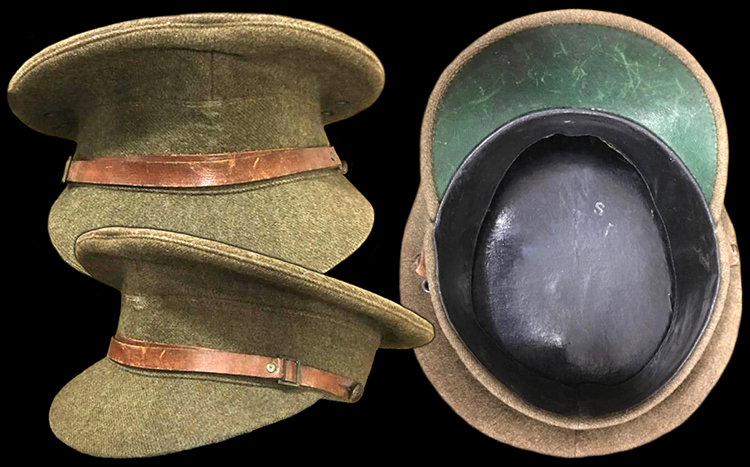
Other Ranks Service Dress Cap.
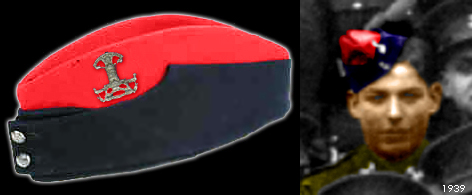
LY Other Ranks Dress Side hat 1940 on becoming Field Artillery,
RA.
World War 2
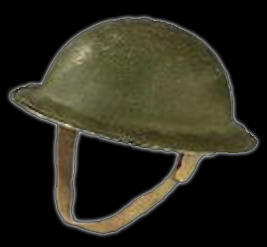
World War II "Tommy" Helmet
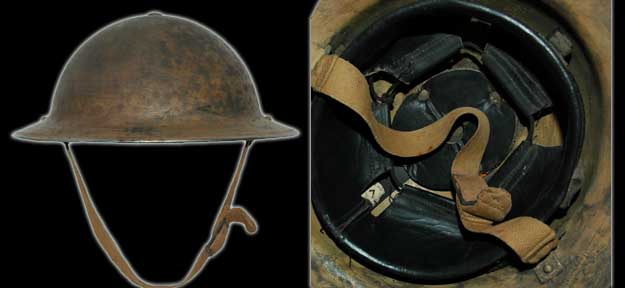
desert camo helmet with tan over paint for North Africa desert
camo.
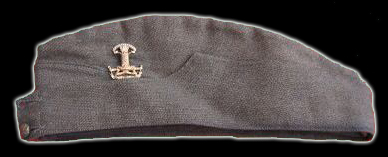
ORs
Field service side cap
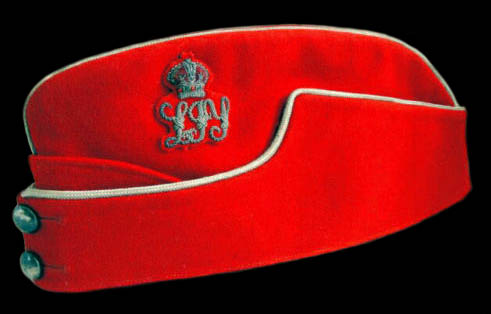
Officers Field Service Cap cWW2
(KC "LIY" bullion cap badge is worn from post 1920-56)
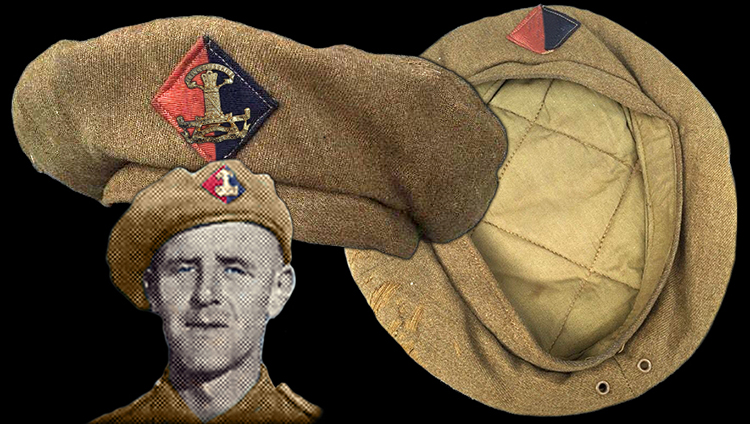
154th
LYPAO FR RA GS Beret, with the Royal Artillery Red/Blue TRF.
Post War

LY Other Ranks No1 Dress Cap as Field Artillery, an all scarlet
cap was introduced for the other ranks on rejoining the Royal
Armoured Corps in 1947.
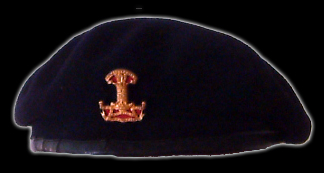
LY Beret (Royal Blue)

L&D (PAOY) Officers Dress Cap c1960's.


L&D (PAOY) Officers Service Dress cap with "Gilt & White
Metal" cap badge (with 15mm rings) and plain white metal strap buttons, c1960's.
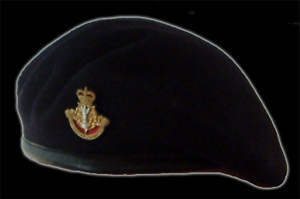
L&D (PAOY) Beret (Royal Blue) with red cloth backed "brass"
badge c1960's.

"Turtle" Battle Helmet.
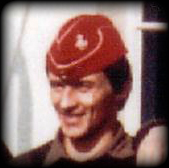
L&D (PAOY) O/R Folding Field Service Cap.
This cap was the same pattern as the Officers and was purchased
from Regiment and Squadron stores. The Cap was worn from 1958
until 1975, this cap had been worn on occasion post 1993.

L&D, PAOY Other Ranks
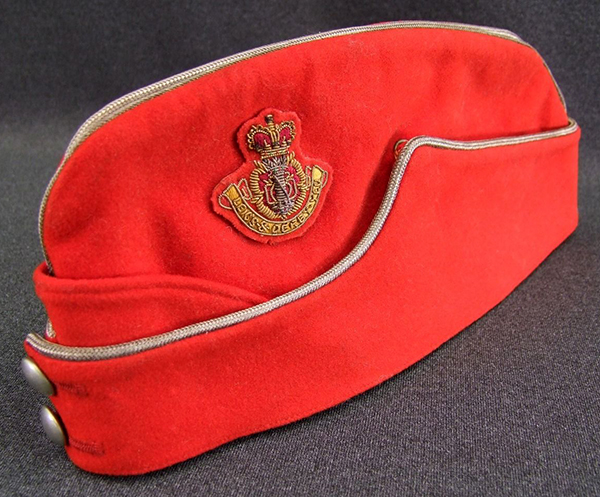
L&D, PAOY Officer

L&D (PAOY) O/R Dress Cap

L&D (PAOY) O/R No2 Mounted Service cap
Last used in 1994 for the
"Year of the Yeomanry" mounted section on a short course at the
Household Cavalry, Windsor. Also used in 1991 for a selection
course for the SAUMUR Cup held at the RAVC, Melton Mowbray,
Leics.

Mk6 Kevlar Helmet.
Used in Iraq and Afghanistan by members of the L&D (PAOY) PAO Squadron.
|